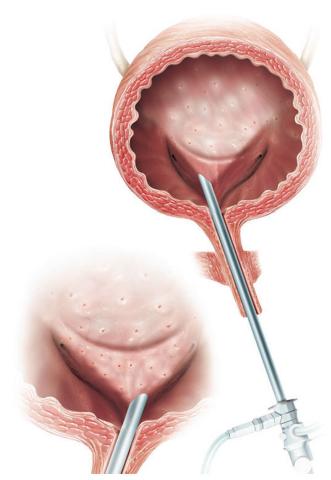This is a procedure that treats Detrusor Overactivity. This is a condition of the bladder that causes frequency, urgency and nocturia. Most patients will have unsuccessfully tried quite a few alternative treatments.
Botox® is actually the tradename of one of the injectable forms of Botulinum Toxin, the actual chemical that causes the desired result – just like Thermos flask has become the common name for a vacuum flask. This particular “brand” has proven the most reliable and best produced for use in the bladder, which has resulted in its widespread adoption for this use.
Who might need Botox Therapy to the Bladder?
People who suffer from detrusor overactivity may require intra-vesical (i.e. inside the bladder) Botox injections.
Detrusor Overactivity can occur spontaneously at any age but is commonly found in people with the following conditions:
-
Stroke.
-
Spinal cord injuries / conditions.
-
Parkinson’s Disease.
-
Multiple Sclerosis.
-
Neurological diseases in general.
The procedure is well tolerated and few people have problems. It often needs to be repeated anywhere from 6 months to a year after injection, depending on how rapidly the effect wears off.
What happens during the procedure?

-
You will receive a full general anaesthetic.
-
Occasionally may also receive an epidural (spinal) as an alternative - your Anaesthetist will discuss this with you.
-
You will be given intravenous antibiotics before the procedure.
-
You will have 20-30 injections made into the bladder wall according to a pre-determined pattern.
-
Often you will also, simultaneously have a hydrodistension of the bladder performed. This is a recognised treatment for Detrusor Overactivity in its own right, but has been shown to enhance the effectiveness of the Botox therapy as well.
Important:
It is important to realize it often takes 2-3 weeks (sometimes longer) for there to an effect from the injection. Be aware of signs of infection - get treatment early!
Side Effects
All operations have the potential for side effects. Most people do not experience any (< 10% of patients actually do), though it is good to be aware of what they might be:
Occasional - < 10%
-
Burning or blood when you pass urine - usually settles in a few days.
-
Temporary insertion of catheter.
Uncommon - < 5%
-
Urinary retention that persists for a number of weeks – this may require you to perform self-catheterisation or have an indwelling catheter inserted until the bladder recovers.
-
Urine infection.
Rare - < 1%
-
Systemic reaction to the Botox itself.
